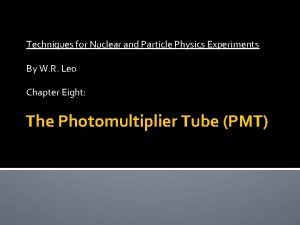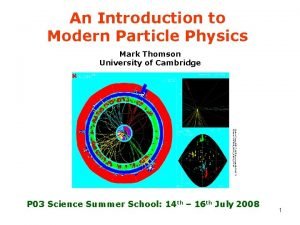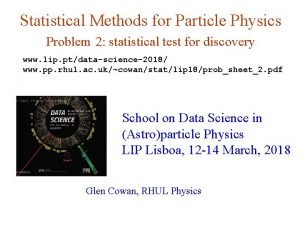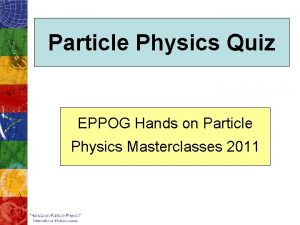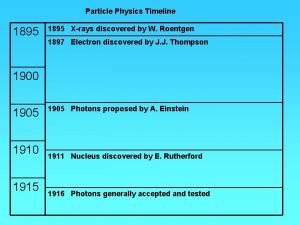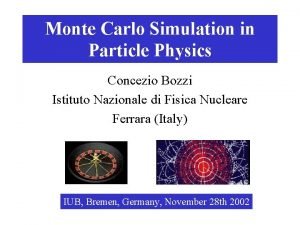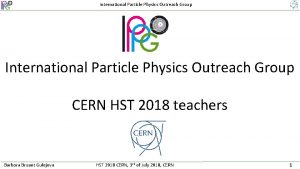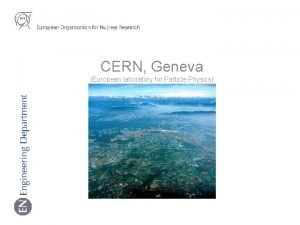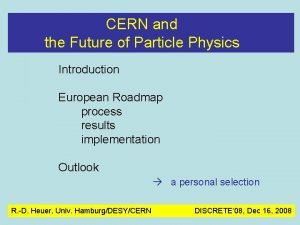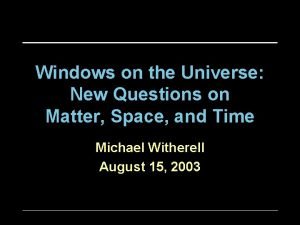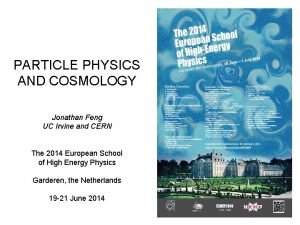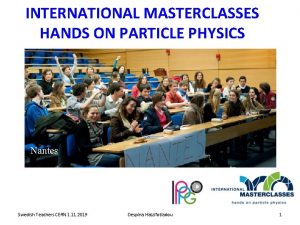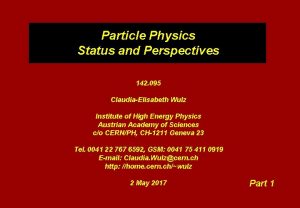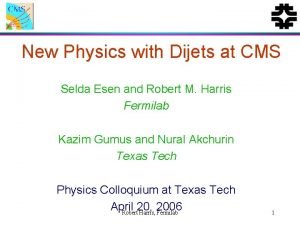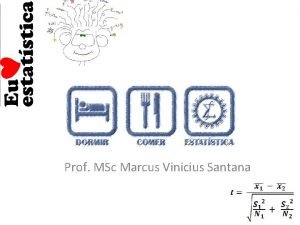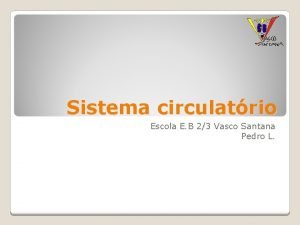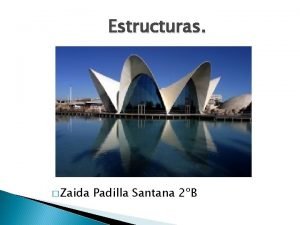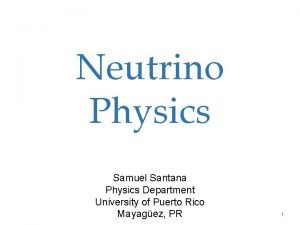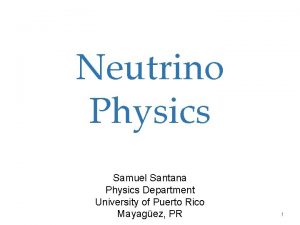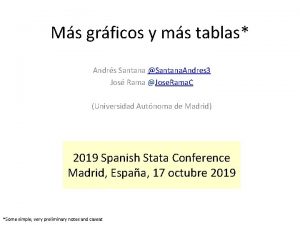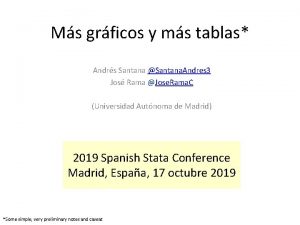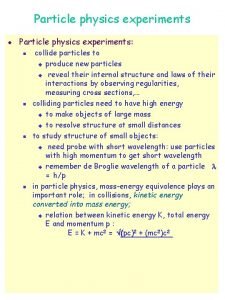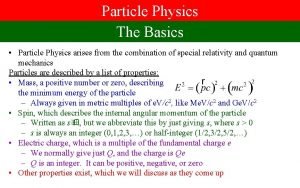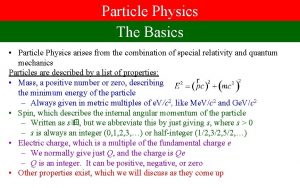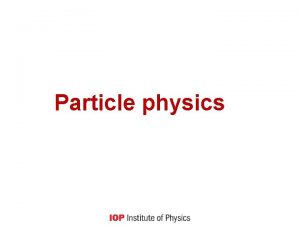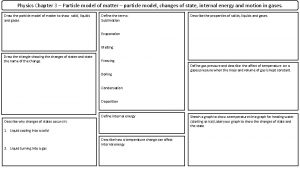The Standard Model of Particle Physics Samuel Santana























- Slides: 23

The Standard Model of Particle Physics Samuel Santana, Ph. D.

What is Particle Physics? • Particle Physics is the study of the (subatomic) particles that constitute matter and radiation and their interactions. • Particle Physics is the study nature at the smallest scales, on the order of 10 million times smaller than nanometers!

What particles are there?

How do we classify these particles? • The theories of Special Relativity and Quantum Mechanics allow us to classify subatomic particles as fermions or bosons. fermions bosons • Make up all known matter • Half-integer spin • Force mediators • Integer spin

The Standard Model (SM) of Particle Physics • This theory allows us to classify all known subatomic particles in terms of a few elementary particles. • Quarks and leptons (and their anti-particles) are fermions that make up all known matter. • The photon, gluon, W and Z are bosons that “carry” the forces. • The higgs boson gives (most? ) particles their mass.

What about the composite particles? Hadrons (composite particles made up of quarks) Fermions (halfinteger spin) Baryons (made up of three quarks) Anti-Baryons (made up of three anti-quarks) Bosons (integer spin) Mesons (made up od a quark and an antiquark)

Some examples

What else does the SM do? • The SM does more than classify particles, it is a mathematical theory that combines Special Relativity and Quantum Mechanics (our two best theories!) to explain nature at its most fundamental level.

• The SM combines three of the four known fundamental forces into a consistent mathematical theory that allows us to make specific predictions and get a deeper understanding of the inner workings of nature. Fundamental Forces of Nature Electromagnetism Weak Nuclear Strong Nuclear Gravity

Quantum Electrodynamics (QED) • QED is the quantum theory of electromagnetism. • QED interactions correspond to electromagnetic interactions. • All particles that have electric charge participate in this interaction. • The photon is the boson responsible of mediating this force. • Is a long range interaction since the photons have no mass.

Quantum Chromodynamics (QCD) • QCD is theory of the strong interactions. • All particles with color charge participate in this interaction. • The gluons (there are eight of them!) are responsible of mediating this force. • Is a short range interaction due to quark confinement.

Weak Interaction •

Gravity • We don’t have a quantum theory of gravity … yet! • It is believed to be mediated by a spin-2 boson called graviton. • It is a long range force. • Don’t know why it is so weak compared to the other forces.


Is the SM the final story? • No. There are many things that the SM cannot explain. • Gravity • Dark matter • Dark Energy • Neutrino masses • Matter – antimatter asymmetry

Particle Detectors • In Particle Physics experiments we are usually interested in measuring/detecting: • The particle’s trajectories. • The linear momentum of the particles. • The energies of the particles.



Inner Detector • We can calculate the momentum of the particles by tracking its path through a magnetic field. • The Inner Detector measures the direction, momentum and charge of electrically charged particles. • The main components of the Inner Detector are the Pixel Detector, Semiconductor Tracker and the Transition Radiation Tracker.

Calorimeter • Allow us to find the energies of electrons and photons. • Designed to absorb most of the particles coming from a collision forcing them to deposit their energy within the detector. • Electromagnetic calorimeters measure the energy of electrons and photons. • Hadronic calorimeters sample energy from hadrons. • Calorimeters can stop most known particles except muons and neutrinos.

• Muons can penetrate several meters of iron without interacting, unlike most particles they are not stopped by any of CMS's calorimeters. • Thus chambers to detect muons are placed at the very edge of the experiment where they are the only particles likely to register a signal. Muon Spectrometer


Thank you!
 Samuel habla señor que tu siervo escucha
Samuel habla señor que tu siervo escucha Pmt particle physics
Pmt particle physics Modern particle physics mark thomson
Modern particle physics mark thomson Particle physics
Particle physics Particle physics practice quiz
Particle physics practice quiz Particle physics timeline
Particle physics timeline Concezio bozzi
Concezio bozzi Cern particle physics
Cern particle physics European laboratory for particle physics
European laboratory for particle physics Cern particle physics
Cern particle physics Particle physics
Particle physics Form factor particle physics
Form factor particle physics International masterclasses hands on particle physics
International masterclasses hands on particle physics Physics standard model
Physics standard model Physics standard model
Physics standard model Blog do vinicius de santana
Blog do vinicius de santana Hva betyr «santana dharma»?
Hva betyr «santana dharma»? Dharma hinduismen
Dharma hinduismen Jales benevides santana filho
Jales benevides santana filho Decir subjunctive
Decir subjunctive Escola vasco santana
Escola vasco santana Lidia santana vega
Lidia santana vega Zaida padilla santana
Zaida padilla santana Carlos santana childhood
Carlos santana childhood

